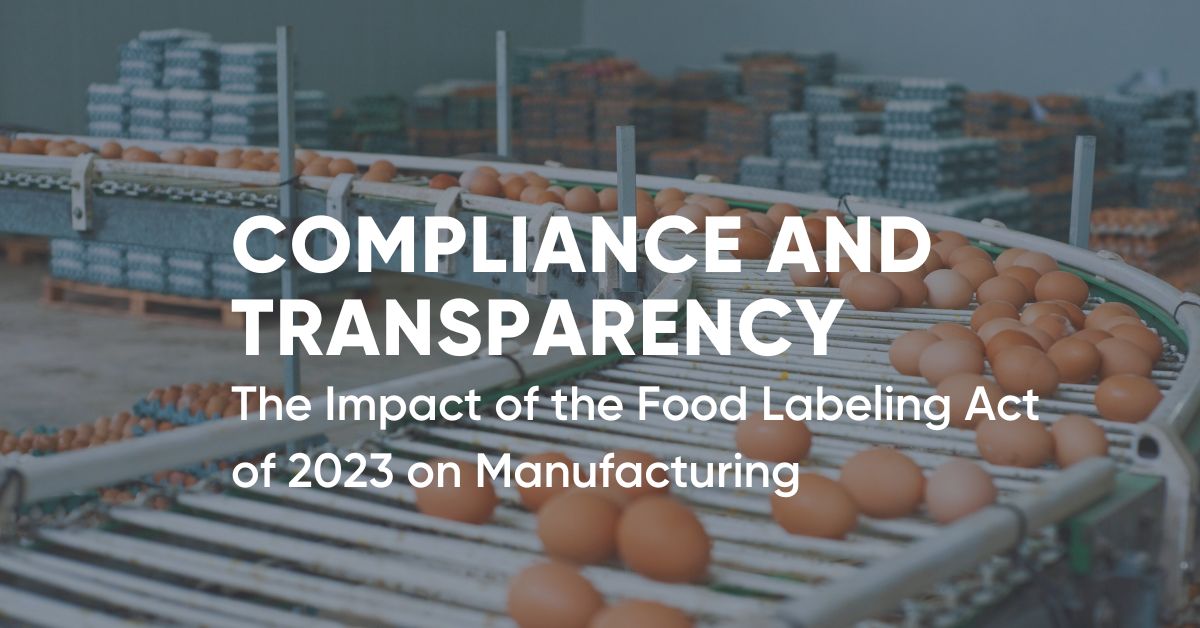On May 9, 2023, a significant development shook the industry with the introduction of the Food Labeling Act, reshaping the way products are labeled and bringing about a new era of transparency and accountability. Sometimes referred to as “Code Date Labeling”, those in the Agriculture and Food & Beverage industries must understand the implications of this new legislation.
The bill requires “the quality date on a food label (i.e., the date after which the quality of the item may deteriorate) to include the phrase BEST If Used By or the abbreviation BB. Similarly, the discard date on a food label (i.e., the date after which the item should not be consumed) must include the phrase USE By or the abbreviation UB. Abbreviations may only be used if the full phrase does not fit on the label (source).”
Manufacturing leaders in this space should investigate adopting innovative technologies like Vision AI as a crucial step toward ensuring compliance and maintaining consumer trust.
Understanding the Food Labeling Act of 2023
This legislation was designed to address several key issues, including:
- Transparency: Consumers have become increasingly conscious about the contents of the products they consume. The act mandates clearer and more accurate labeling, providing consumers with vital information about ingredients, nutritional content, and potential allergens in a more consistent and easier-to-understand way.
- Health and Safety: Ensuring the safety of consumers is paramount. The act imposes stricter guidelines on food labeling to mitigate health risks associated with misleading or incomplete information.
- Environmental Concerns: With growing awareness of sustainability issues, the act also emphasizes transparency regarding the environmental impact of food production and packaging. Increasing clarity of labeling and relaxing overly stringent state food donation restrictions, will also help to reduce food waste while better serving communities.
The Food Date Labeling Act of 2023 would:
- Establish a dual label system reducing the available labeling language to two phrases: one quality date indicator and one discard date indicator.
-
- If a manufacturer chooses to use a date to indicate a food product’s quality, it must use the phrase “BEST if Used By” or “BB” if the package has limited space.
- If a manufacturer chooses to use a date to indicate when food should be discarded for safety reasons, it must use the standard language “USE By” or “UB” if the package has limited space.
- A manufacturer may add ‘‘or Freeze By’’ following a quality date or discard date uniform phrase.
-
- Eliminate state laws that bar the sale or donation of food past the quality date. However, states would still be allowed to prohibit the past-date sale or donation of foods bearing the “Use by” discard date.
- Instruct the USDA and FDA to work together to educate consumers and food companies about the meaning of new labels so that they can make better economic and safety decisions.
The Importance of Compliance
Compliance with the Food Labeling Act is not just a legal obligation; it’s a commitment to integrity and consumer welfare. Failure to comply can result in significant consequences, including fines, recalls, damage to brand reputation, and loss of consumer trust. Even in today’s rapid news cycles, a food product recall can have long-lasting impacts on product sales.
Manufacturing leaders must recognize the importance of adhering to these regulations and implement robust systems to ensure compliance throughout the production process.
Vision AI has multiple benefits
In the era of Industry 4.0, advanced technologies like vision AI are revolutionizing the manufacturing landscape. Vision AI involves the use of cameras and machine learning algorithms to analyze visual data in real-time, offering unprecedented levels of accuracy and efficiency.
A well-trained Vision AI model can recognize:
- Misplaced code date labels and if that misplacement is critical enough to interrupt production
- Legibility: Is the printer low on ink? Is there enough contrast between the ink color and the packaging color? Is the printing smudged and hard to read?
By catching these and other errors, manufacturers can reduce errors and the waste of mislabeled products.
Here’s how Vision AI can help food and beverage manufacturers stay compliant with the Food Labeling Act:
- Food Date Labeling: By leveraging advanced image recognition algorithms, Vision AI can accurately analyze product packaging to identify date labels such as “BEST If Used By” or the abbreviation “BB.” This technology not only streamlines the process of monitoring expiration dates but also reduces the risk of human error. Manufacturers can implement Vision AI systems to automatically detect any discrepancies between the labeled dates and regulatory standards, thereby enhancing overall compliance and consumer safety.
- Ingredient Recognition: Vision AI can identify ingredients with remarkable precision, ensuring that products are labeled accurately and by regulatory requirements. This technology can detect even minor deviations or inconsistencies, reducing the risk of mislabeling errors.
- Quality Control: In addition to regulatory compliance, Vision AI can enhance overall product quality by detecting defects, contaminants, or irregularities in the manufacturing process. By maintaining high standards of quality control, manufacturers can uphold consumer trust and safeguard their reputation.
- Packaging Verification: The Food Labeling Act extends beyond product labeling to include packaging materials and environmental claims. Vision AI can verify the accuracy of packaging labels, assess environmental impact statements, and ensure compliance with sustainability standards.
The Food Labeling Act of 2023 has ushered in a new era of transparency and accountability in the food and beverage industry. For manufacturing leaders, compliance with these regulations is non-negotiable, requiring a proactive approach and the adoption of innovative technologies like vision AI.
By leveraging vision AI for ingredient recognition, allergen detection, quality control, and packaging verification, manufacturers can uphold the integrity of their products, mitigate risks, and build trust with consumers.
Enhance compliance with VisionAI! Click here to get started.
Are you an Indiana-based manufacturer? Join the Vision AI Pilot Program

